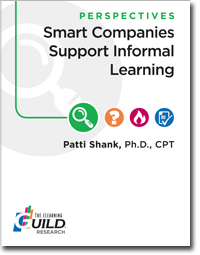You may not (at first) think that informal learning is so critical to workplace learning until you stop to think about how you learn almost everything you do at work. It’s probably not in a classroom or from eLearning, right? Let’s say you need to figure out how to fill out a new travel form. What do you do? Sign up for a class? Nah. You ask someone who has filled it out before. Or see if there’s a document that explains it.
The first report under our new research report framework (see last month’s article where I explained how we’re doing research reports now) came out in August 2012 and is Smart Companies Support Informal Learning (Figure 1).

|
|
Figure 1: The eLearning Guild’s Smart Companies Support Informal Learning. |
In this article, I’ll provide some food for thought from that report that I hope will get you thinking about informal learning and why it’s so critical to the success of the people working inside your organization. The answer to the question posed by the title of this article is VERY IMPORTANT! (Keep reading, okay?)
Is “informal” what’s left over after defining formal learning?
The first issue the report considers is defining informal learning. Michael Eraut, professor of education at the University of Sussex Institute of Education in Brighton, UK, says that we too often treat informal learning as a leftover category to describe whatever learning “does not take place within, or follow from, a formally organised learning programme or event.” So Eraut starts by defining the term “formal learning” as having any or all of the following characteristics:
- a prescribed learning framework
- an organized learning event or package
- the presence of a designated teacher or trainer
- the award of a qualification or credit
- the external specification of outcome
But unfortunately, Eraut, like so many others, defines informal more for what it isn’t (i.e., formal) than what it is. I was therefore on a quest to find a better definition for informal learning and found it in Saul Carliner’s book, Informal Learning Basics. I adapted one of Dr. Carliner’s definitions: Informal learning includes situations where the learner determines some or all combinations of the process, location, purpose, and content, and may or may not even be aware that instruction has occurred.
If it’s not defined by what it’s not, then what is it?
Why was it so important to have a definition? Because informal learning is a really big deal when it comes to workplace learning. Numerous studies show that the vast majority of learning in the workplace happens not in formal training environments but informally. In fact, these studies show informal learning as a proportion of all workplace learning at a whopping 50 to 80 percent.
Think about how you typically learn and work and you begin to realize how much you depend on co-workers, conversations, networking, the Internet, collaboration, and so on.
Informal learning is what workers rely on most
One part of the report that was especially interesting, and probably aggravating for most people in our line of work, was the examples where workers were asked what most supports their workplace learning. Formal training was not high on the list. For example, sales and marketing representatives and representatives of management and the HR department at Sara Lee were asked to rate the relative importance of a number of workplace learning activities—the results are shown in the pie chart in Figure 2. As you can see, job experience and networking were highest on the list.
This result was comparable to a survey compiled by Jane Hart that showed that collaboration, self-directed study, conversations with others, networks, and blogs were essential and very important ways to learn in the workplace.

Figure 2: From the Guild’s Smart Companies Support Informal Learning.
Source:
http://www.elearningguild.com/research/archives/index.cfm?id=159&action=viewonly and
http://www.informl.com/2010/01/26/an-example-of-informal-learning-from-europe/
Since this research report clearly points out how critical informal learning is to workplace learning, I asked Dr. Carliner to share some important takeaways from his book about how to support informal learning in an organization. One caveat that I’ll share with you in this article is that it’s critical that training and development professionals not go overboard with command and control when they support informal learning. If they do they are likely to kill it. And since informal learning makes up the bulk of learning inside organizations, this could be a truly perilous move.
Got your interest? Stay tuned for the report on social learning!
I hope this information from the Guild’s Smart Companies Support Informal Learning research report has improved your interest in learning more about how to support informal learning in your organization. One of my conclusions, when writing this report, was that we ought to put a greater percentage of our training and development dollars towards supporting informal learning, and I think you’ll understand why.
Ben Betts’s research report on social learning will be released midday today, and you won’t want to miss it! My goal is to provide you with rich and accessible research resources to help you improve your practice and make important decisions. If you have any questions or comments about the Guild research reports, don’t hesitate to contact me at pshank@elearningguild.com.



